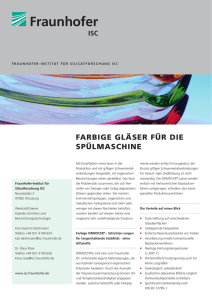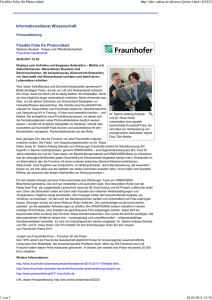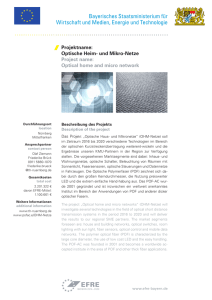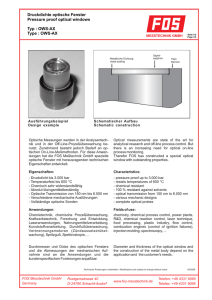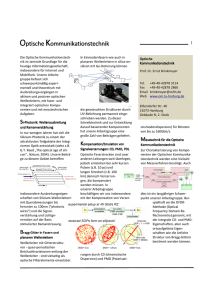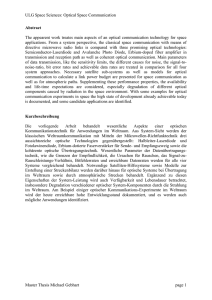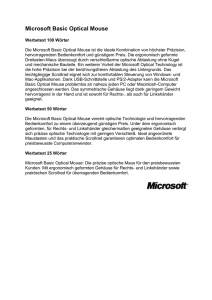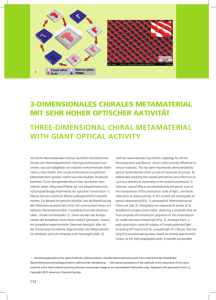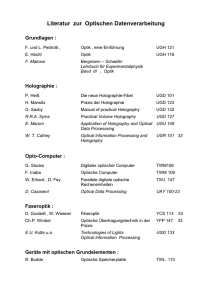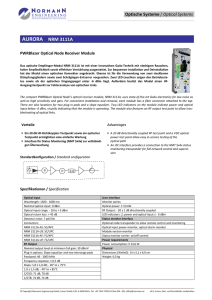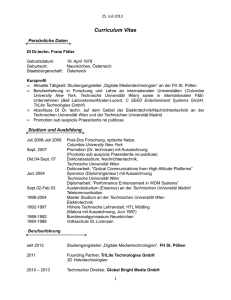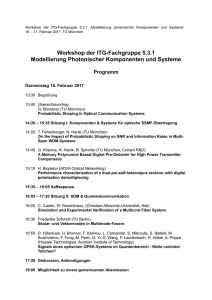materials for optical packaging
Werbung
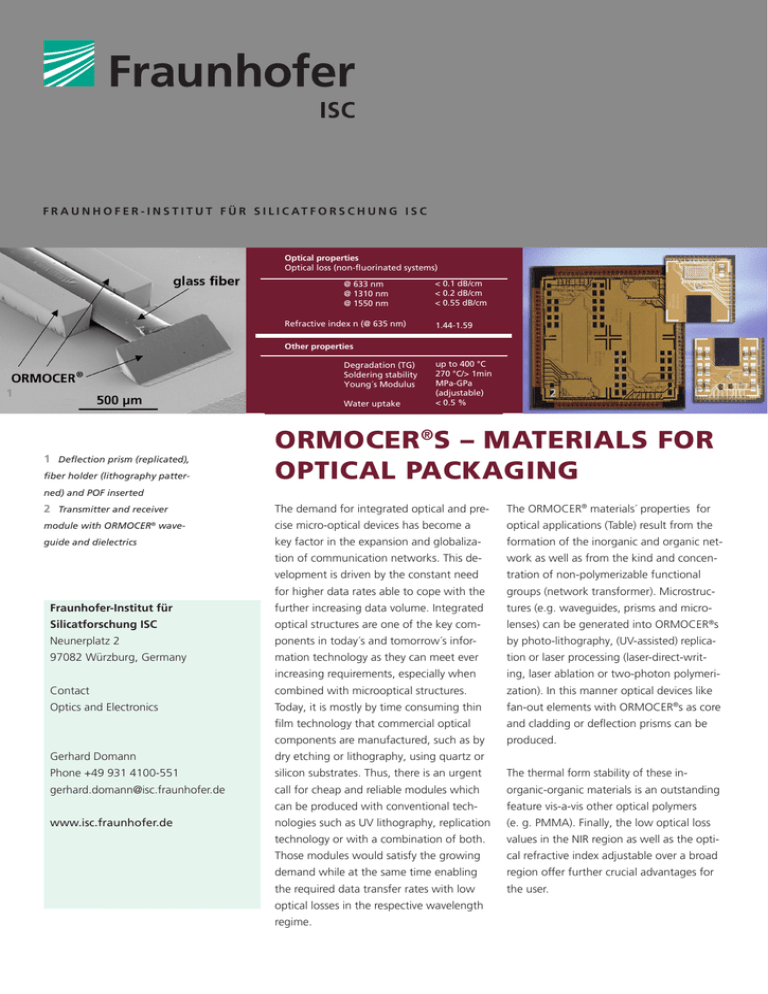
F R A U N H O F E R - I N S T I T U T F Ü R S I L I C AT F O R S C H U N G I S C Optical properties Optical loss (non-fluorinated systems) < 0.1 dB/cm < 0.2 dB/cm < 0.55 dB/cm @ 633 nm @ 1310 nm @ 1550 nm Refractive index n (@ 635 nm) 1.44-1.59 Other properties 1 Degradation (TG) Soldering stability Young´s Modulus 1 Water uptake 1 Deflection prism (replicated), fiber holder (lithography patter- 2 up to 400 °C 270 °C/> 1min MPa-GPa (adjustable) < 0.5 % 2 ORMOCER®S – MATERIALS FOR OPTICAL PACKAGING ned) and POF inserted 2 Transmitter and receiver The demand for integrated optical and pre- The ORMOCER® materials´ properties for module with ORMOCER® wave- cise micro-optical devices has become a optical applications (Table) result from the guide and dielectrics key factor in the expansion and globaliza- formation of the inorganic and organic net- tion of communication networks. This de- work as well as from the kind and concen- velopment is driven by the constant need tration of non-polymerizable functional for higher data rates able to cope with the groups (network transformer). Microstruc- Fraunhofer-Institut für further increasing data volume. Integrated tures (e.g. waveguides, prisms and micro- Silicatforschung ISC optical structures are one of the key com- lenses) can be generated into ORMOCER®s Neunerplatz 2 ponents in today´s and tomorrow´s infor- by photo-lithography, (UV-assisted) replica- 97082 Würzburg, Germany mation technology as they can meet ever tion or laser processing (laser-direct-writ- increasing requirements, especially when ing, laser ablation or two-photon polymeri- Contact combined with microoptical structures. zation). In this manner optical devices like Optics and Electronics Today, it is mostly by time consuming thin fan-out elements with ORMOCER®s as core film technology that commercial optical and cladding or deflection prisms can be components are manufactured, such as by produced. Gerhard Domann dry etching or lithography, using quartz or Phone +49 931 4100-551 silicon substrates. Thus, there is an urgent The thermal form stability of these in- [email protected] call for cheap and reliable modules which organic-organic materials is an outstanding can be produced with conventional tech- feature vis-a-vis other optical polymers nologies such as UV lithography, replication (e. g. PMMA). Finally, the low optical loss technology or with a combination of both. values in the NIR region as well as the opti- Those modules would satisfy the growing cal refractive index adjustable over a broad demand while at the same time enabling region offer further crucial advantages for the required data transfer rates with low the user. www.isc.fraunhofer.de optical losses in the respective wavelength regime. F R A U N H O F E R - I N S T I T U T F Ü R S I L I C AT F O R S C H U N G I S C Optische Eigenschaften Dämpfung (nicht-fluorierte Systeme) < 0,1 dB/cm < 0,2 dB/cm < 0,55 dB/cm @ 633 nm @ 1310 nm @ 1550 nm Brechzahl n (@ 635 nm) 1.44-1.59 Sonstige Eigenschaften 1 Degradation (TG) Lötstabilität E-Modul 1 2 Wasseraufnahme 1 Prisma (repliziert), Faserhalterung (strukturiert durch Photolithographie) und POF 2 Multichipmodul (MCM) für 4 bis zu 400 °C 270 °C/> 1min MPa-GPa (einstellbar) < 0.5 % 2 ORMOCER®E – MATERIALIEN FÜR DIE AUFBAU- UND VERBINDUNGSTECHNIK Module, Transmitter und Empfänger Zukünftige Telekommunikations- und Die Materialeigenschaften der ORMOCER®e Datennetzwerke erfordern zuerst die für optische Anwendungen (vgl. Tabelle) Entwicklung neuer Netzwerkkomponen- resultieren aus der Ausgestaltung des an- ten, um den immer höheren Datendurch- organischen und organischen Netzwerks Fraunhofer-Institut für satz zu bewältigen. Integrierten optischen sowie aus der Art und Konzentration von Silicatforschung ISC Bauteilen, zum Teil auch in Kombination nicht polymerisierbaren, funktionellen Neunerplatz 2 mit mikro-optischen Strukturen und Kom- Gruppen (Netzwerkwandlern). Mikrostruk- 97082 Würzburg ponenten, kommt eine wichtige Schlüs- turen (z. B. Wellenleiter, Prismen und selrolle zu, da der Bedarf an kostengüns- Mikrolinsen) in ORMOCER®en können Ansprechpartner tigen Schnittstellen steigt. Die bisher für durch Photolithographie, (UV-unterstütz- Optik und Electronik diesen Zweck verwendeten und kom- te) Replikation oder Laserverfahren (Laser- merziell erhältlichen Bauteile werden in Direkt-Schreiben, Laserablation oder Zwei- Gerhard Domann aufwendiger Weise durch Dünnschicht- Photonen-Polymerisation) erzeugt werden. Telefon +49 931 4100-551 technik (z. B. Trockenätztechniken, Litho- So können optische Bauteile, wie z. B. [email protected] graphie) auf Quarz- oder Siliciumsubstra- Fan-out-Elemente mit ORMOCER®en als ten hergestellt. Gefordert sind hier preis- Wellenleiterkern und -mantel oder werte, zuverlässige Module, gefertigt mit Prismen, hergestellt werden. www.isc.fraunhofer.de kostengünstigen Technologien, z. B. optische Lithographie, Replikation oder einer Im Vergleich zu anderen optischen Polyme- Kombination von beiden. Solche Module ren (z.B. PMMA) zeigen ORMOCER®e eine können den Bedarf an günstigen Kompo- bessere thermische Formstabilität. Schließ- nenten ebenso befriedigen wie die Forde- lich bieten die geringen Dämpfungswer- rung nach hohen Datentransferraten bei te im NIR-Bereich sowie die in weiten Be- geringen optischen Verlusten in den nutz- reichen einstellbare optische Brechzahl der baren Wellenlängenbereichen. ORMOCER®e weitere entscheidende Vorteile für die Anwender.
